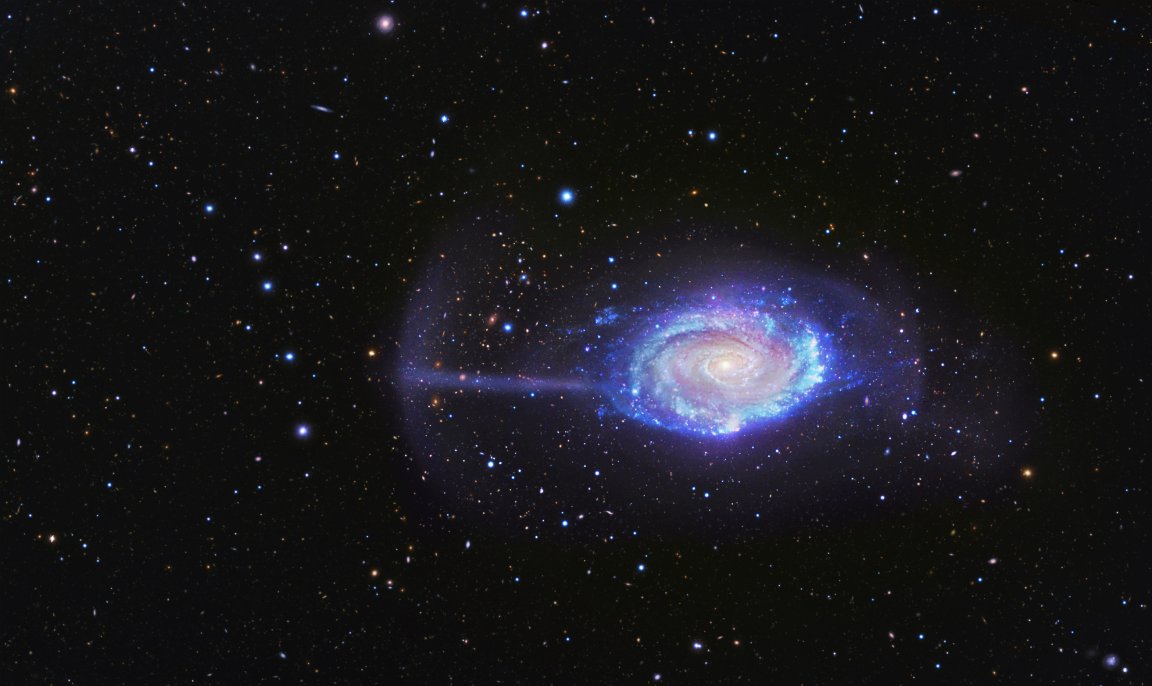

Lurking about 62 million light-years from Earth is a galaxy worth celebrating, called NGC 4651 (otherwise known as the Umbrella Galaxy).
This beautiful island universe is a spiral galaxy found in the Coma Berenices constellation. Though it’s more unconventional than the Milky Way looks-wise, both share many of the same characteristics.Namely, both are roughly the same size, each spanning approximately 100,000 light-years across. Both also have a bright central disk. The difference is, as the nickname suggests, NGC 4651 has two faint wisps of material that intersect, ultimately making the galaxy resemble a cosmic umbrella. Impressively, the main wisp spans nearly twice as long as the galaxy itself (about 100,000 light-years beyond the disk and its tenuous halo).
Though perplexing at first, astronomers have now come to the conclusion that the wisp is a tidal tail (like those seen surrounding the Antennae Galaxies), one generally left behind following a gravitational encounter, or a merger of two galaxies. The latter appears to be the culprit here, with the region showing signs of multiple gravitational perturbations. However, recent research suggests otherwise.
Researchers, led by Caroline Foster of the Australian Astronomical Observatory (AAO), used observations obtained from the Subaru and Keck telescopes in Hawaii in order to track the movement of the stars in the stream and make this determination. The movements of the stars were tracked using globular clusters, planetary nebulae, and patches of hydrogen gas in the galaxy. When scientists discovered the Umbrella galaxy in the 1950s, they initially thought that the parasol structure was a companion dwarf galaxy. But Foster’s research indicates that what we though was a dwarf galaxy is actually the remains leftover from a previous meal.
“Through new techniques we have been able to measure the movements of the stars in the very distant, very faint, stellar stream in the Umbrella,” Foster explained in a statement from the AAO. “This allows us to reconstruct the history of the system, which we couldn’t before.”
But before you start thinking that the Umbrella galaxy is the Milky Way’s evil twin, keep in mind that our own galaxy was formed in a similar manner: by cannibalizing several smaller galaxies. There are star crumbs (like bread crumbs, but way cooler) leading to a nearby galaxy (the Sagittarius dwarf galaxy). Ultimately, these star trails act just like the trail of bread crumbs that Hansel and Gretel used to find their way back from the Gingerbread house in the forest. The cosmic equivalent helps us trace the source of the cosmic creation responsible for warping the Umbrella Galaxy’s shape, and similarly, it reveals that the Milky Way is consuming stars from Sagittarius.
And it seems that the eating habits of the Milky Way and Umbrella are not unique. A 2010 study that examined 8 spiral galaxies revealed that 6 of them had signs of similar mergers.
[Reference: “Cosmic Cannibalism: The Surprising Eating Habits of the Umbrella Galaxy“]
See a larger image here.